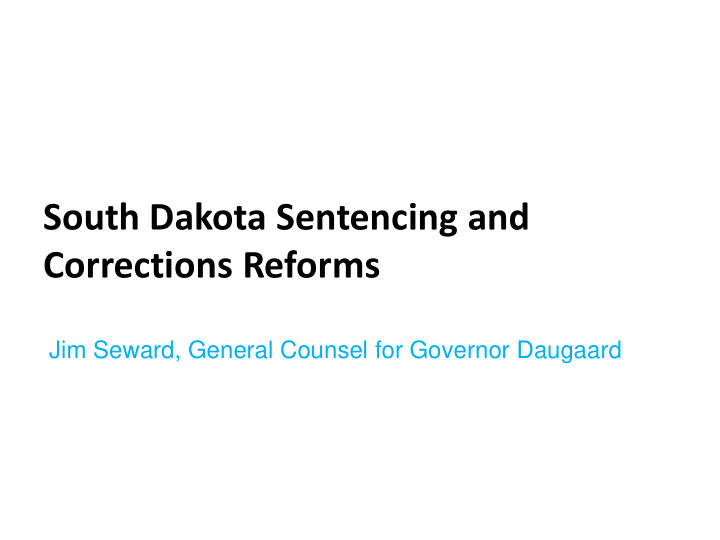



South Dakota Sentencing and Corrections Reforms Jim Seward, General Counsel for Governor Daugaard
South Dakota’s prison population rose more than 500% in the past 35 years South Dakota’s Prison Population 4000 3535 3500 3000 2500 2000 1500 1000 500 0 1977 1979 1981 1983 1985 1987 1989 1991 1993 1995 1997 1999 2001 2003 2005 2007 2009 2011 Source: Department of Justice, Bureau of Justice Statistics, Prisoner Series.
Crime and Imprisonment: 2000 to 2010 Overall Crime Imprisonment Rate Rate United States -19% +1.6% South Dakota -9% +18% • SD’s imprisonment rate has risen more than the national average • State’s decline in crime rate has not kept pace with the national reduction Source: Department of Justice, Bureau of Justice Statistics, Prisoner Series. Federal Bureau of Investigation, Uniform Crime Reports. Overall crime rate is the violent crime rate plus the property crime rate.
Over 80% of prison admits were convicted of nonviolent crimes • Over 80% of offenders FY12 Admissions for New Commitments admitted to prison sentenced for nonviolent crimes Other Violent 9% • Over 50% were for drug or 19% Nonviolent DWI alcohol crimes Person 22% 1% • 70% of drug offender Property 18% inmates are in for Drug possession (30% for 31% distribution/manufacturing) Source: South Dakota Department of Corrections
1 out of 4 prisoners in for a parole violation • The length of time parole Prison Population by Admission Type, July 2012 violators serve in prison had grown 28% since FY05 • Offenders spent 43% Parole longer on parole in FY12 Violator 25% than in FY00 • While some had more New Other serious violations as well, Commitment 5% 70% in a one month sample, 45% of parole revocations involved a drug or alcohol condition violation Source: South Dakota Department of Corrections
South Dakota’s Spending on Corrections 2000: 5.8% of General Fund 2000: 5.8% of General Expenditures Fund Expenditures Up 75% Up 75% 2010: 6.8% of General Fund 2010: 6.8% of General since since 2000 Expenditures Fund Expenditures 2000 $77 Million in 2010 $77 Million in 2010 Source: South Dakota Bureau of Finance and Management
South Dakota Criminal Justice Initiative Work Group Goals of the Criminal Justice Initiative: 1. Improve public safety by investing in programs, practices, and policies that have been shown to improve rehabilitation and reduce repeat offenders. 2. Hold offenders more accountable by strengthening community supervision. 3. Reduce corrections spending and focus prison space on violent, chronic, and career criminals. The working group did not address topics such as: Juvenile justice, death penalty Root causes of crime such as education, poverty, etc. Drug Legalization
Criminal Justice Initiative Work Group Process • 35+ stakeholder meetings 6 meetings from July through October 2012 – Analyzed state data including prison, parole, probation, and sentencing information – Examined evidence based practices proven to reduce recidivism – Assessed policy examples • Work reviewed and guided by Council of Advisors
Criminal Justice Initiative Work Group Policy Areas Protect public safety and reduce Supervision and recidivism by holding offenders on Reinvestment supervision more accountable Utilize prison space for violent and Statutory Review career criminals Ensure reforms are sustained and Sustainability intended outcomes are achieved 8
Supervision and Reinvestment Policies 1. Focus supervision on high-risk offenders • Earned discharge credits on parole & probation • Improved financial accountability system 2. Improve the supervision of probationers and parolees • Tribal parole supervision pilot • HOPE courts 3. Create programs to enhance supervision and improve outcomes • Increased treatment dollars • Requires evidence based practices, including graduated sanctions 9
Statutory Review Policies 1. Differentiate among levels of criminal conduct • Increased penalties for the most serious property crimes & DUI offenders. • Tiered controlled-substance statute, up and down, based on level of criminal conduct 2. Create presumptive probation for Class 5 and 6 felonies • Probation supervision unless the individual poses a significant risk to public 3. Ensure that judges maintain authority to use 180 day sanctions for probationers; swift and certain. 10
Sustainability Policies 1. Measure and evaluate implementation of reforms • Oversight council – monitor and evaluate implementation • 10 year fiscal impact statement 2. Improve training on evidence-based practices • DOC, UJS, & DSS develop performance/outcome measures and provide semi-annual reports • Regular training for judges, parole board members, probation and parole officers 3. Improve efficiency and accessibility of systems • Limits preliminary hearings • Reinvestment funding structure for counties 11
Anticipated impact of SB 70 5,000 4,580 4,500 4,000 3,636 3,864 3,500 3,000 2,500 2,000 1,500 1,000 500 0 2000 2001 2002 2003 2004 2005 2006 2007 2008 2009 2010 2011 2012 2013 2014 2015 2016 2017 2018 2019 2020 2021 2022 Historical Prison Population Projected Prison Population Impact of SB 70 Source: South Dakota Department of Corrections (historical data); The Pew Charitable Trusts (projections)
Reinvestment Total over 10 years: $207 million saved and $53M reinvested $177,000 for training and implementation of evidenced-based practices $438,000 for pilots, which are based on the Hawaii Opportunity Probation with Enforcement, or HOPE, approach $250,000 for pilot supervision programs involving the parole system and $8 Million Native American tribes Year 1 $250,000 for the Department of Corrections to establish a housing pilot to improve outcomes for offenders released to parole $800,000 for a statewide automated victim information and notification, or SAVIN, system $300,000 for a financial accountability system for offenders $725,000 into drug and DUI courts to expand these options to areas across the state with the greatest need $4.9 Million $3.2 million in expanded substance abuse, mental health, and cognitive-based Years 2-10 treatment services for probation and parole populations $825,000 for probation and parole staff and evidenced-based practices training $100,000 for SAVIN system
Contact Info • Jim Seward – Office: 605-773-3661 – Email: jim.seward@state.sd.us
Recommend
More recommend